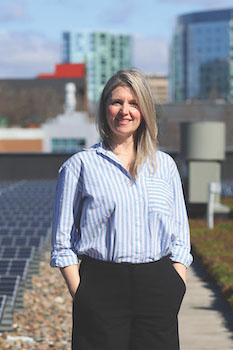There’s no other holiday quite like Halloween. Children get to dress up like ghouls and goblins, shout ‘Trick or treat,’ and fill their bags with candy, all while reveling in the thrill of spooky stories and haunted houses. It's a time for creativity, imagination, and community gatherings.

But there’s a growing awareness around the holiday’s environmental impact. From the mountains of pumpkin waste (about each year in the U.S.) to the millions of kilograms of textile waste generated by costumes, Halloween’s fun comes at a significant cost to the planet.
As Halloween approaches, many of us get excited about costumes, decorations, and, of course, treats. But have you ever thought about the environmental impact of all that fun? With this in mind, more people are beginning to ask what they can do to ensure Halloween doesn’t turn into an environmental nightmare.��
We spoke to Stephanie MacPhee (shown left), executive director in Dal’s Office of Sustainability, about some of the sustainable alternatives this spooky season to help reduce waste and make a positive impact on our planet.
What are some sustainable alternatives to plastic costumes and decorations, and how can we encourage their reuse to minimize landfill waste?
Alternatives include using items we already have in our closets, borrowing items from friends and family. Consider renting a costume, borrowing from a friend or family member, shopping in thrift stores for used items and using platforms like Marketplace. Often when we make purchases we think, it is just one time, just one thing but multiple that by the number of people doing the same thing, buying the same plastic, disposable, costume and it’s quite impactful. So, choosing a more sustainable alternative does have a very tangled, positive environmental impact that is amplified as more people make those choices.
How can we design Halloween decorations that are safe for wildlife considering the potential risks of items like spider web-style gauze trapping wildlife?
Consider DIY projects with items you can find outside or around your house/apartment. Leaves, twigs, glass jars, bed sheets, soy, or beeswax candles, get creative. Use edible materials like pumpkins and other squash. You can also use decorations bought from thrift stores or through other second-hand online platforms like Marketplace. If you do go ahead with store-bought decorations, try to buy items that are not single use, that will last for years to come. Also remember to consider wildlife when buying decorations as items like fake spider webs can entangle birds and insects and cause them harm.
What innovative solutions exist for repurposing pumpkin waste after Halloween?
When purchasing pumpkins, buy locally. There are no shortage of options in the Halifax Regional Municipality (HRM). Keep your pumpkin uncarved for as long as possible so you have more options for how to use it after Halloween. Instead of carving your pumpkin use non-toxic paints or markers to decorate it, which will ensure it stays fresh and makes it available for your favorite recipe post-Halloween. There are also options to donate your pumpkins to feed animals at local farms. For example, the North Mountain Animal Sanctuary in Annapolis Valley accepts donations of pumpkins (ideally uncarved as they provide the most nutrition to their animals).
What strategies can we implement to reduce waste from Halloween treats, particularly focusing on improving the sorting of wrappers to enhance recycling efforts?
Buy locally produced treats (e.g. Peace by Chocolate), choose fairtrade chocolate. By buying fairtrade certified chocolates and other goods, you can be assured that workers who were involved in its production were paid a fair wage, provided decent working conditions, and farmers and workers in the countries where commodities like cocoa are from receive a fair deal. It’s also certified to ensure no child or forced labour was used in its production. It may be a bit pricier but cheap items often come at a cost to those on the production side.
In terms of waste reduction and recycling, look for items with minimal packaging, paper packaging (which is recyclable), and buy in bulk. Most treats are wrapped in single-use plastics, which are not recyclable (chip bags and snack wrappers are not recyclable in HRM, for instance). Be sure to check the sorting guidelines so you can properly sort the items you collected during trick or treating.
In what ways can our choices this Halloween promote sustainable practices and broader environmental awareness?
In general, it is important to remember that although disposal and recyclability are important considerations, the biggest impact you can have is reducing your waste in the first place by reusing items, using natural materials, and minimizing consumption around the holidays. Often the more significant environmental impact and carbon footprint is associated with the production and shipping of the items we purchase. That is often more significant than the disposal part of the equation. It’s important to consider the amount of energy, water, and materials that went into the production of these goods. Were the individuals who made them paid a fair wage, do they work in safe conditions, where was it shipped from? These are all particularly important elements we often forget to consider when we make our purchases.
These sustainable practices are part of a larger picture. This isn’t just about Halloween; it’s about adopting a mindset that values sustainability in every aspect of life. The choices we make during this holiday reflect broader environmental considerations. By making informed choices and encouraging our communities, we can create a ripple effect that transforms Halloween into a time of fun and environmental change.

